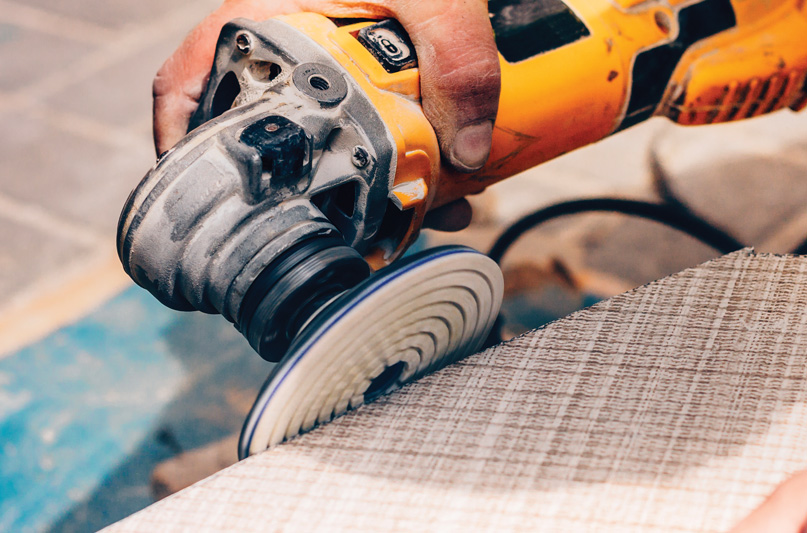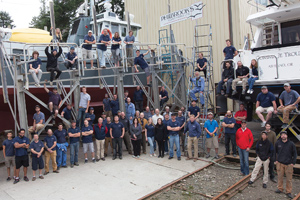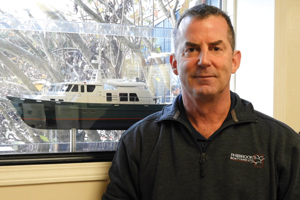
“The whole difference between construction and creation is exactly this: that a thing constructed can only be loved after it is constructed; but a thing created is loved before it exists.”
– G.K. Chesterton, The Pickwick Papers
The definition of composites is a broad one: materials made from two or more different components that produce a unique compound. That’s the fancy way to say that you add one and two to get three. Given that fiberglass composites are the dominate recreational boat materials of the day, the topic is worth taking a closer look.
While the dynamic science of fiberglass composites constantly evolves in labs across the world, the application of the product is a skilled trade and an entire career path. Full service boatyards all have composite teams who can take care of those unsightly gelcoat cracks and make critical structural repairs to a bulkhead or keel. Beyond just the practical, these gurus are also the ones who can make that swim step addition a reality through a custom modification job. Honestly, the work of an ace fiberglass composite expert is magical to behold as they transform buckets of resin and mats of woven fiberglass into the boat of our dreams. These boatyard craftspeople turn the science of composite materials into works of nautical art.
To learn more about this wizardry, we turn to Les Margetts, a lead fiberglass composites expert who has worked at Philbrook’s Boatyard in Sidney, British Columbia, for the last 17 years. Margetts sees it all from the cosmetic to the luxury modifications to the structural overhauls.
NWY: When a boatyard says they do composite work, what exactly does that mean? What is the fundamental science going on with all composite work?
For Philbrook’s Boatyard, composite work means anything dealing with fiberglass from repairs and custom fabricated parts to hull extensions. The fundamental concept behind composite work is mixing different materials to get a stronger product. The science—composite work is very much a science—is knowing which different materials and chemicals to use, how to mix them properly, and the best products to use on different jobs. You would also need to know about the different resin types such as polyester, vinyl ester, and epoxy.
NWY: When it comes to major structural repairs, how does one go about it? Walk us through a hypothetical bulkhead repair.
We did a bulkhead repair recently. The first step was to determine what caused the problem. In this case it was a water leak. The second item we looked at was what was the best and most cost-efficient way to repair it. Then the third step was getting together a game plan and discussing it with the owner. After all that, we began the work.
The next stage was the setup of the work site and preparing the ventilation for the crew. The location of this repair was a bulkhead between the engine and lazarette. The first major decision was to do the repair work from the lazarette side, as to not disturb the engine room equipment. We installed a temporary support wall on the engine room side. From the lazarette side, we removed the outer laminate which exposed the wet core that was then removed.
With the inner laminate intact, we reinforced it with two layers of glass reinforcement (2408 Biax). Once cured, we made a template and then cut and installed a new foam bulkhead that was bonded in place. Next four layers of 2408 was glassed over the core. The area was then prepped and gelcoated. It looked good as new.
NWY: Do you have any insight for boat owners about when collision or impact damage should be considered? Is there a rule of thumb between a minor bump that is cosmetic and a structural incident?
In my opinion, there isn’t really a rule of thumb when it comes to whether a minor bump is cosmetic or structural. I look at how much damage is done, which means going over this entire area inside and out. Some major impacts can cause lots of unseen damage that can be missed if not thoroughly examined. Quite often the extent of the damage is not found until the area is opened up.
If it was a minor item, I call it a ‘love tap.’ Minor items are strictly cosmetic, which means they are gelcoat repairs with no structural damage that can wait to be repaired. Any structural damage should be repaired as soon as possible to prevent other damages occurring. This would depend on water intrusion, bulkhead damage, or stringer damages which would lead to other issues.
NWY: What are the most common types of composite repairs you make at Philbrook’s? Why do you think
that is?
It’s very common for us to see many different types of repairs; however, we tend to do more gelcoat cosmetic repairs. With boats, there is lots of movement overtime. I think people see any cracks and begin to panic, fearing there is deeper damage. Cracked gelcoat just doesn’t look good. Other years, we can see lots of what we like to call ‘rock hoppers,’ these would have more keel damage on them. Most people think these never happen because of the technology we have on boats but the rough waters on the West Coast can still be a challenge for people.
NWY: Can you talk a bit about the importance of matching gelcoats and non-skid colors and patterns?
Matching gelcoat is a science which takes a very special talent and an eye for color. It takes a very talented person to know the right products to use as boats fade over the years. We want the gelcoat to remain blended for years to come. I’ve seen many cases of repairs turning yellow from improper use of thinners and promoters. It’s the same with non-skid patterns, they are difficult to repair due to varieties of pattern shapes, whether molded gelcoat or hand-applied, rolled-on gelcoat. In most cases for non-skid repairs, it’s best to repair a full panel depending on the size.
NWY: Can you walk us through the process of matching gelcoats and non-skid patterns?
First, we clean and polish an area of the boat’s gelcoat that is consistent with the area being repaired. Then a small dab of gelcoat is placed onto the surface. Polyester gelcoat pigments are added a little at a time until the desired color is achieved.
The process is a bit like a recipe. Regarding the repair area, broken and cracked gelcoat needs to be removed until a stable material is reached (ex. non-hydrolyzed glass). For the repair, mask the area with tape tightly and fill high (slightly over the tape level) with thickened gelcoat. When the gelcoat cures (minimum 24 hours), rough down to the tape with power tools and block sand after removing the tape until surface is fair (or slightly lower if an application of sprayed gel will be used next). Mask off the area to be sprayed, then apply thin gel, and spray area. Allow to cure for 24 hours, block sand until fair, and polish with a fiberglass rubbing compound.
Matching gelcoat in a non-skid pattern is most difficult, as very few types of non-skid can be recreated. Regular diamond patterns in small areas can be filled, ground flat, and carved by hand. Grip Tex type non-skids can be retouched by spray blending. Rolled gelcoat stippling can be recreated by mixing 3 to 1 gel coat to Cabosil. Saturate a roller and test on a dry surface until desired stipple height is reached.
NWY: Extensions and modifications can include anything from a swim step addition to a cabinet. What are some differences in approach between a repair and a modification job?
With a repair job, most clients come because of damage. The damage is then repaired back to original factory specs. With modifications, owners would like to make changes to the original specs. They want to remove or make additions to something. An example of some modifications we’ve done are to bench seats, lockers, or even BBQ areas. With modifications, we are looking at cost and overall structural changes to the boat. Is it cost effective for the customer? How does it affect the boat? Repairs by contrast are done out of necessity and tend to be less creative in nature.
NWY: What are some of the most memorable modification jobs you’ve been a part of?
The best part of working at Philbrook’s is that there are so many different custom jobs. One was Cristina Mia, a Meridian that we extended five feet to add a retractable swim step and custom seating. All finished in gelcoat. Ten years later, you cannot see the difference from the old/new gelcoat blends. Unfortunately, the owner has now painted his boat, ha!
We are also very proud of our latest job, which was a 130-foot full refit called Northern Dream. We were able to build a custom hardtop, full cockpit extension, customs lockers, and a new BBQ area.
NWY: Do you have tips for boaters who want a major modification to go well in the yard?
Your engine’s alternator is a useful tool for recharging your batteries, but most stock alternators are pretty low amperage and will take a long time to recharge your batteries, especially at idle. I recommend upgrading your stock alternator to a high output, externally regulated alternator that will provide “smart” charging for your batteries.
On twin engine boats, or boats with heavy generator use, I often find one of the alternators is not even working but boat owners don’t notice because the batteries are staying charged through other sources. To test the output of your alternator, use the DC amp clamp setting on your multimeter, and clamp around the biggest red cable coming from your alternator. It’s important to only clamp one cable at a time or you will not get a good reading.
Run your engine and check your alternator amperage at idle. Increase your RPM and you should see the amperage rise. Put a large load on your batteries and see if your alternator keeps up with the demand.
NWY: Maintenance seems to be key. How do you keep track of what the Northwest Explorations fleet needs, and how can this be applied to boat owners?
Before coming in, do your research and get organized. Come with a plan and budget. If it’s a very large job, prep the boat beforehand. Remove as many belongings as possible from the boat. Empty out the fridges and personal belongings, especially if the work is inside the boat.
NWY: What’s the ceiling on the typical DIYer out there who is interested in doing composite work aboard? Are there jobs you recommend trying vs. jobs best left to the pros?
Good question and a tough one to answer. It all comes down to what is their experience and how tough a job it is. If it’s minor, I don’t mind talking people through the job. However, anything structure-related or any really large jobs should be left to the pros to deal with. I have seen jobs where the owner has started on some minor repairs and then it’s grown into something bigger. Then the owner shows up with the boat torn apart. Don’t get in over your head.
NWY: Do you see any new technological game changers coming to the composite world anytime soon (new materials, processes, etc.)?
Due to the typical repairs and custom work we do here, we don’t get to use the high-tech stuff as they would in a production shop. We don’t have molds. We build custom parts using one-off molds, which get destroyed after use. We don’t get to infuse or vacuum bag as much as production shops do.
One thing I see a lot of in our shop is new lightweight cores which are much stronger. Composite technology is always changing. It’s all around us, not just the boat industry. Automotive, aircraft, and much, much more.
NWY: What can boaters do to extend the life of a composite job?
For any boater, they should watch for cracks, checks for leaks, and make sure that the hardware is sealed properly. Keep it clean, dry water in bilges, and wax your boat. Regular maintenance does wonders, it really is that simple!




